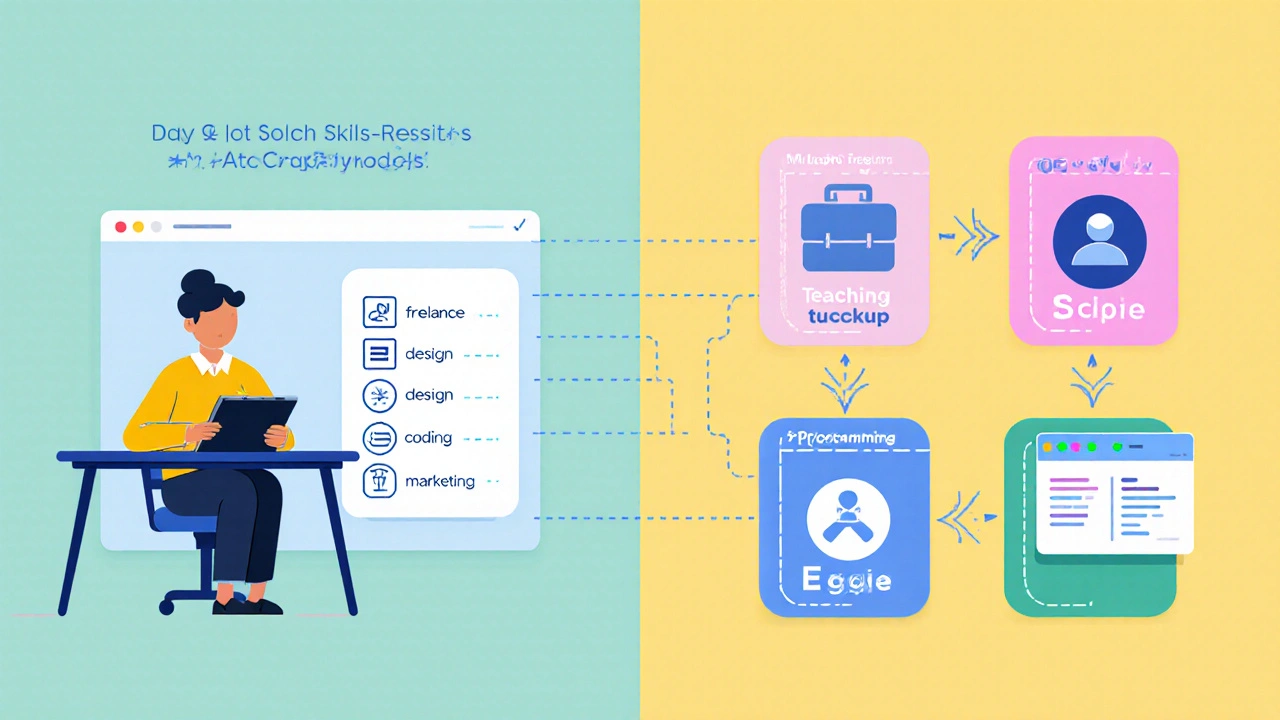
Side Hustle Skills Matcher
Discover Your Best Side Hustle Skills
Enter your top 3 skills below to discover which side hustle models match your abilities.
Feeling stuck in your 9‑to‑5 and wondering what you could actually sell on the side? The truth is you already own a bundle of abilities that can be packaged into a profitable side hustle. The trick is to surface those talents, match them with market demand, and launch quickly before doubt pulls you back.
Key Takeaways
- Start with a quick self‑audit to list hard and soft skills you already use daily.
- Map each skill to at least one proven side‑hustle model that fits your time constraints.
- Validate demand with a tiny test - a single gig, a mini‑project, or a short survey.
- Set realistic earnings targets based on industry averages and your skill level.
- Iterate fast: refine the offering, price, and marketing after each client interaction.
When we talk about side hustle skills, we mean the concrete abilities you can turn into cash outside your primary job. Below is a compact definition that anchors the rest of the guide:
Side hustle skills are the abilities and knowledge you can leverage to earn extra income beyond your main employment.
Step1: Conduct a Fast Skill Audit
Grab a notebook or a digital note app and answer three prompts:
- What tasks do I perform effortlessly at work or in my personal life?
- Which software, tools, or platforms am I comfortable with?
- What compliments do friends, family, or colleagues give me about my abilities?
Write each answer as a bullet point. You’ll likely see familiar themes emerge: data analysis, visual design, writing, teaching, or problem‑solving.
Step2: Match Skills to Proven Side‑Hustle Models
Below are nine high‑demand gig categories, each paired with a skill set you might already possess. The first occurrence of every category includes microdata markup so search engines can recognize the entities.
Freelancing offering project‑based services such as copywriting, translation, or consulting on platforms like Upwork or Fiverr works well if you have strong communication or specialized expertise.
Online tutoring providing subject‑specific lessons via video chat or pre‑recorded courses leverages teaching experience or deep knowledge of a school subject.
Graphic design creating logos, social media assets, or marketing flyers using tools like Canva or Adobe Photoshop suits visual‑oriented people who enjoy layouts and branding.
Content writing producing blog posts, SEO articles, or newsletters for businesses seeking fresh copy is ideal for those who love research and storytelling.
Digital marketing managing ads, email campaigns, or SEO for small businesses that need online visibility taps into analytical thinking and creative ad copy skills.
E‑commerce selling physical or digital products on platforms like Etsy, Shopify, or Amazon fits makers, curators, or anyone who can source niche products.
Virtual assistance handling email, calendar, data entry, or customer support for busy entrepreneurs matches organized multitaskers.
Programming building websites, automations, or custom scripts for clients who need tech solutions is perfect for coders comfortable with languages like Python, JavaScript, or Ruby.

Step3: Quick Comparison Table
| Skill Category | Typical Side‑Hustle | Entry‑Level Earnings (USD/month) | Time Commitment (hrs/week) | Key Tool |
|---|---|---|---|---|
| Writing & Editing | Content writing | 200‑800 | 5‑10 | Google Docs |
| Visual Design | Graphic design | 300‑1,200 | 6‑12 | Canva / Photoshop |
| Data Analysis | Freelance consulting | 400‑1,500 | 4‑8 | Excel / PowerBI |
| Teaching & Coaching | Online tutoring | 150‑900 | 3‑6 | Zoom / Google Meet |
| Software Development | Programming gigs | 500‑2,500 | 5‑15 | VSCode |
| Social Media Savvy | Digital marketing | 250‑1,000 | 4‑10 | Meta Ads Manager |
| Organizational Skills | Virtual assistance | 200‑800 | 5‑12 | Asana / Trello |
Step4: Validate Demand Before You Commit
Testing the market costs less time than building a full‑scale service. Follow these three lightweight steps:
- Offer a free sample. Create a one‑page article, a short logo, or a 15‑minute tutoring session and share it with your network. Track how many people ask for more.
- Post a micro‑gig. Use a platform like Fiverr or Upwork to list a $5‑$10 starter service. Record the conversion rate from view to order.
- Survey your target audience. Ask a small group on Facebook or LinkedIn what price they’d pay for the solution you’re considering. Use a Google Form to collect responses.
If at least 2‑3 people show genuine interest, you have a green light to scale.
Quick‑Start Checklist
- ✅ List 5‑7 core skills you already use daily.
- ✅ Choose 2‑3 side‑hustle models that align with those skills.
- ✅ Create a simple portfolio or sample (one article, one design, one code snippet).
- ✅ Set a realistic hourly or project rate based on the table above.
- ✅ Publish the gig on at least one platform and promote it in relevant online groups.
- ✅ Record all client interactions, earnings, and time spent for the first month.

Common Pitfalls & How to Dodge Them
Over‑pricing early on. New freelancers often assume their expertise is worth premium rates. Start modest, gather testimonials, then raise prices gradually.
Choosing a hustle that doesn’t fit your schedule. If you’re juggling a full‑time job, avoid projects that demand unpredictable hours (e.g., 24/7 customer support).
Neglecting contracts. Even informal gigs benefit from a simple written agreement that outlines scope, payment, and deadlines. A Google Docs template works fine.
Skipping the feedback loop. After each delivery, ask the client for one concrete improvement. Iterative tweaks sharpen your offering faster than any course.
Resources & Next Steps
Use these free or low‑cost tools to accelerate your launch:
- Canva - quick graphic creation.
- Google Workspace - collaborative docs and spreadsheets.
- Calendly - easy scheduling for tutoring or consulting.
- Fiverr, Upwork, and PeoplePerHour - gig marketplaces with built‑in payment protection.
- HubSpot’s free CRM - track leads and follow‑ups without a steep learning curve.
Once you’ve completed the first month, revisit the earnings table, compare actual numbers, and decide whether to specialize further or diversify into a second side‑hustle.
Frequently Asked Questions
How do I know which skill is most marketable?
Start by checking platforms like Upwork’s “Most In‑Demand Skills” list and matching it against your audit. Skills that appear both in your list and high‑demand rankings are prime candidates.
Do I need a professional website to start?
Not at first. A clean profile on a gig platform plus a one‑page portfolio (hosted on Carrd or a LinkedIn summary) is enough to land the first client.
What’s a realistic income target for a beginner?
Most beginners earn between $200 and $500 in the first month, depending on the niche and hours invested. Treat this as a proof‑of‑concept phase.
How much time should I allocate each week?
Aim for 5‑10 hours spread over evenings or weekends. Consistency beats occasional marathon sessions.
Can I combine multiple side hustles?
Yes, but keep them complementary. For example, pair content writing with digital marketing services for the same client to increase value and simplify management.





